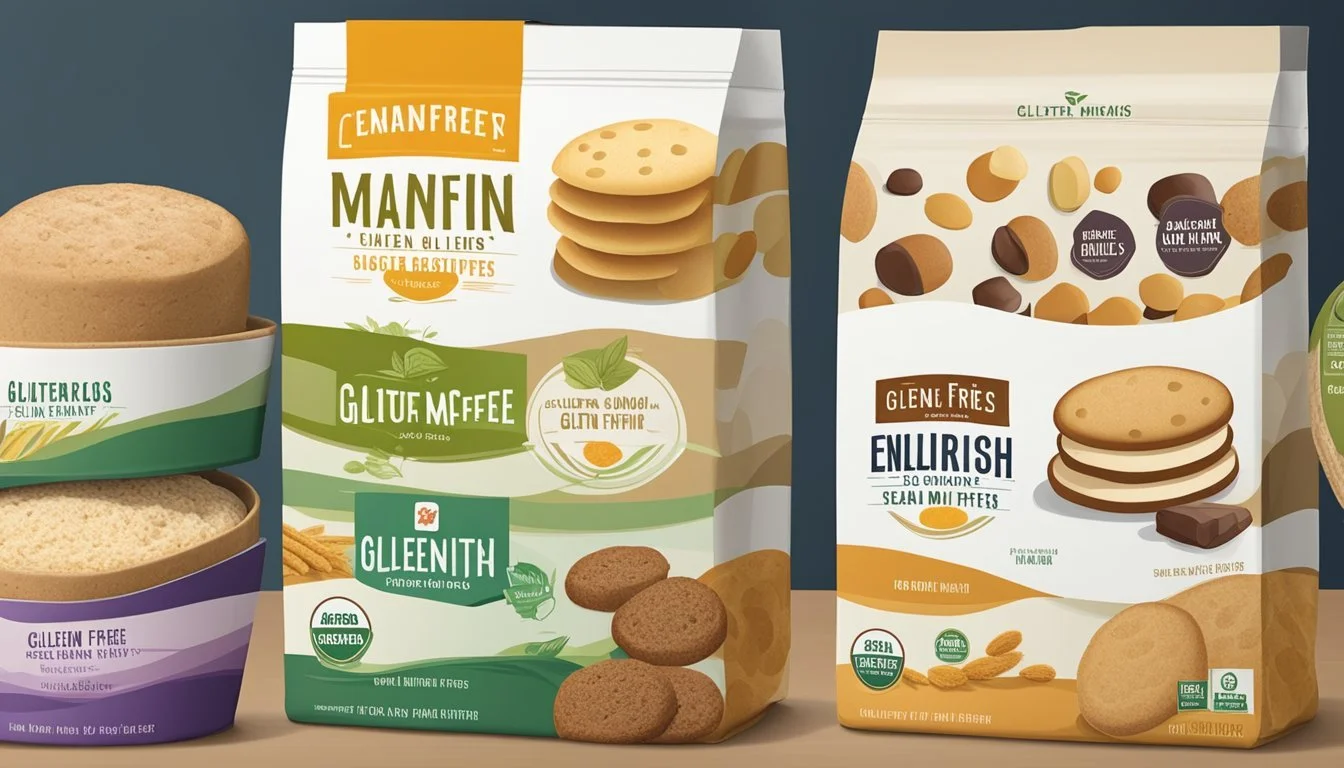English Muffin Substitutes
Top Alternatives for Your Breakfast Needs
When it comes to crafting a satisfying breakfast, the English muffin is a staple in many households. Its unique texture, with a crispy exterior and soft, airy interior marked by nooks and crannies, makes it ideal for absorbing melted butter, jams, or serving as the base for eggs Benedict. However, there are instances when the traditional English muffin may not be available or when dietary preferences call for an alternative.
Substitutes for English muffins can be found in various forms of bread and baked goods that provide a similar texture or flavor profile. A bagel, with its dense, chewy interior and shiny crust, makes a suitable replacement, especially when toasted. For those seeking a yeast-leavened bread with a soft consistency, gugelhupf—particularly the plain variety—serves as an effective alternative for savory applications. Other replacement options include buttermilk biscuits and certain crusty bread, which offer the requisite crispness and tenderness that one typically associates with an English muffin.
Adapting recipes to accommodate these substitutes can ensure that breakfast remains a delightful meal, even without the presence of traditional English muffins. With a little culinary creativity, these alternatives not only fill the gap but also broaden the breakfast horizon with a range of flavors and textures.
Understanding English Muffins
In exploring English muffins, one must consider their historical significance, distinctive features, and nutritional content. These aspects define their role in culinary practices, especially as a breakfast staple.
History and Popularity
English muffins originate from the United Kingdom where they were first referred to simply as "muffins." Their creation dates back to the 10th or 11th century, gaining prominence in the Victorian era as a part of the English high tea tradition. These muffins became popular in the United States in the late 19th century when Samuel Bath Thomas introduced them to New York City. Today, they are a ubiquitous breakfast item, often enjoyed as part of a breakfast sandwich.
Key Characteristics
The defining feature of English muffins is their unique texture marked by nooks and crannies that are ideal for trapping melted butter and other toppings. Unlike traditional muffins, an English muffin is a type of bread rather than a cake. It is round, typically about 3 to 4 inches in diameter, made from a yeast-leavened dough, and cooked on a griddle. The dough is firmer than that used for making cakes, resulting in a dense and chewy product after being fork-split and toasted. The surface is characteristically dusted with cornmeal, adding to its signature texture.
Nutritional Value
English muffins offer a range of nutrients that contribute to a balanced diet. Here's an overview in a tabular format for clarity:
Nutrient Contribution in English Muffins Protein Provides a source of protein, important for muscle maintenance Calcium Often contains calcium, essential for bone health Vitamins May include B vitamins, particularly if whole wheat is used
A standard English muffin can be a calorie-controlled option with the average one providing around 120 to 140 calories. Whole-wheat varieties offer more fiber and nutrients compared to their white flour counterparts. When used as a part of a balanced meal, it can contribute to the overall nutritional value, particularly when paired with protein-rich foods such as eggs or lean meats.
Bread-Based English Muffin Alternatives
When seeking a substitute for English muffins, it's essential to consider the texture and how the alternative complements dishes such as sandwiches (What wine goes well with sandwiches?) or eggs Benedict. Bread-based options offer a variety of textures, from the crisp crust of a bagel to the soft, flaky layers of a croissant.
Bagels
Bagels are an excellent alternative with a dense, chewy interior and a glossy, firm crust. They can hold up to a generous spread of butter or the heft of sandwich ingredients without falling apart. Typically boiled before baking, bagels have a distinct texture that adds a satisfying bite.
Croissants
Croissants, known for their buttery flavor and flaky layers, offer a lighter option. While structurally different from English muffins, croissants can be sliced and toasted to create a delicate, yet rich base for a variety of toppings. However, their airy texture might not be as sturdy for heavy sandwich fillings.
Wheat Bread
Wheat Bread, especially when toasted, can be a wholesome substitute with a firmer crust and a soft interior. Whole wheat bread contains more fiber and nutrients compared to white bread, contributing an earthy flavor and a slightly denser texture that can complement both sweet and savory toppings, making it versatile for different types of sandwiches.
Non-Bread English Muffin Substitutes
When traditional bread-based options are unsuitable, various non-bread alternatives can effectively replace English muffins. These substitutes are ideal for those seeking gluten-free options or simply a different texture and flavor profile for their meal.
Pancakes
Pancakes, though typically enjoyed sweet, can be a savory base for toppings typically associated with English muffins. For a healthier option, one might opt for whole grain or buckwheat pancakes, which provide a firmer texture. It's important to cook them until just crispy on the outside to better mimic the crunch of an English muffin.
Plain Yogurt with Toppings
Plain yogurt, especially the thicker Greek yogurt, serves as a creamy substitute. It can be topped with ingredients that one would usually put on an English muffin. For a balanced combination, one might add fresh fruit for sweetness and granola for crunch, emulating the textural contrast of an English muffin. The key is to use plain yogurt as a neutral base to better complement a variety of toppings.
Homemade English Muffin Recipes
Preparing English muffins at home allows one to experience the delight of warm, freshly baked bread with no additives or preservatives commonly found in store-bought varieties.
Traditional Homemade English Muffins
For Traditional Homemade English Muffins, the key ingredients include all-purpose flour, yeast, a touch of sugar for the yeast activation, and a pinch of salt for flavor. One begins by whisking together the warm water, sugar, and yeast, allowing the mix to sit until frothy, indicating active yeast. This yeast mixture is added to the flour and other ingredients in a mixing bowl. The dough is then mixed to form a soft, sticky composition.
Ingredients:
All-purpose or bread flour
Active dry yeast
Sugar
Salt
Warm water
After mixing, the dough should be covered and allowed to proof until it doubles in size. Subsequently, the dough is shaped into rounds and then cooked on a medium-hot griddle or skillet until each side is golden brown. Typically, no oven is needed for traditional muffin recipes, as the cooking process is completed on the stovetop.
Vegan English Muffin Variations
Vegan English Muffin Variations swap out any animal-derived ingredients for plant-based alternatives. The use of non-dairy milk, such as almond or soy, and oil in place of butter are common substitutions. Vegan recipes might also include a binding agent like flaxseed to replace eggs.
Ingredients:
Vegan-friendly flour (all-purpose or bread flour)
Non-dairy milk alternative (e.g., almond milk)
Active dry yeast
Sugar or alternative sweeteners
Salt
Oil or vegan butter
In the vegan recipe, after preparing the yeast with the non-dairy milk and sweetener, the mixture is added to the flour in a mixing bowl. The ingredients are mixed and handled similarly to traditional recipes, with a proofing time followed by shaping and cooking them on a prepared griddle or skillet until they've achieved a desirable consistency and color.
Both traditional and vegan muffin variations can be tailored to include whole-wheat flour or gluten-free options, providing an array of choices for those with dietary preferences or restrictions.
Gluten-Free and Plant-Based Options
In catering to those following a gluten-free and plant-based lifestyle, replacing conventional ingredients in English Muffins is essential. Both flour and dairy ingredients can be substituted effectively with alternatives that maintain texture and flavor.
All-Purpose or Bread Flour Substitutes
For gluten-free English muffins, traditional wheat-based all-purpose or bread flour is swapped out for gluten-free flour blends. These blends often include a combination of rice, potato, tapioca, and possibly almond flour to emulate the texture of wheat flour. Measure-for-measure gluten-free flour blends are available which are specially designed to be direct substitutes in baking.
Almond Flour: A protein-rich, low-carb alternative adding a slightly nutty flavor.
Oat Flour: Offers a similar consistency to wheat flour and adds a hint of sweetness.
Dairy-Free Modifications
When modifying English muffins to be plant-based, dairy elements are substituted with non-dairy alternatives.
Milk: Dairy milk in recipes can be replaced in a 1:1 ratio with plant-based milks such as almond milk or oat milk, both of which yield a light texture and contribute to the moistness of the muffin.
Dairy Ingredient Plant-based Substitutes Cow's milk Almond milk, Oat milk
Butter: Coconut oil is an excellent dairy-free fat substitute that can be used to create a tender crumb in English muffins. It should be used in its solid form to closely mimic the function of butter in the dough.
By using these alternatives, individuals observing a gluten-free and plant-based diet can still enjoy a delectable English muffin that aligns with their dietary preferences.
Healthier English Muffin Choices
When seeking healthier alternatives to traditional English muffins, one should consider options that incorporate whole grains and have low sugar content. These considerations can lead to not only a more nutritious breakfast choice but also one that is suitable for those monitoring their sugar intake or those who are lactose-intolerant.
Benefits of Whole Grains
Whole grains are a healthier substitute to refined grains because they retain essential nutrients such as fiber, vitamins, and minerals.
Whole Wheat Flour: A popular choice for a healthier English muffin is whole wheat flour which provides more fiber and nutrients compared to white flour. This can benefit the digestive system and contribute to a feeling of fullness.
Nutrient White Flour English Muffin Whole Wheat Flour English Muffin Fiber Lower Higher Vitamins Fewer More Minerals Fewer More
Low-Sugar Options
For those reducing their sugar intake, whether they are diabetic or simply health-conscious, selecting an English muffin that is low in sugar is paramount.
Sugar Content: Read the labels to choose English muffins with minimal added sugars. Sugar doesn't only relate to sweetness but also to the overall carbohydrate content.
Lactose Content: English muffins made without milk or butter are suitable for those who are lactose-intolerant, ensuring no unintended lactose consumption.
By focusing on whole grains and low sugar options, consumers can make healthier choices without sacrificing taste or texture.
Cooking Techniques and Storage Tips
In crafting the perfect English muffin substitute, one's attention must hone in on the intricacies of baking techniques and storage practices to maintain freshness and flavor.
Proper Baking Methods
Baking Sheet and Parchment Paper: To start, one must prepare a baking sheet, ideally lining it with parchment paper to prevent sticking. The substitute dough needs a consistent heat distribution, and the parchment aids in this while also making clean-up a breeze.
Skillet and Griddle Use: For those opting to use a skillet or an electric griddle, the surface should be preheated to a moderate temperature, typically between 325 to 350 degrees Fahrenheit. A light coating of non-stick cooking spray ensures the dough does not adhere to the surface, allowing for an even golden-brown finish without added oils.
Long-Term Storage Solutions
Freezer Storage: Long-term preservation of English muffin substitutes is best achieved by storing them in the freezer. They should be cooled completely, then wrapped securely in plastic wrap or placed inside a freezer bag to guard against freezer burn and preserve the quality.
Refrigerator Tips: For short-term storage, the refrigerator offers convenience. The muffins should be placed in a sealed container or wrapped in plastic to retain moisture and freshness for when they are ready to be enjoyed again.
By respecting these guidelines, one can ensure that either homemade or store-bought alternatives to English muffins will stay delicious until their next use.
Food Pairings and Serving Ideas
Choosing the right English muffin substitutes can transform a simple meal into a delightful experience. Whether seeking to craft a wholesome breakfast sandwich or to apply a sweet or savory topping, the alternatives presented give diners a versatile base for their culinary creations.
Breakfast Sandwich Inspirations
Classic Egg Sandwich: A gugelhuph sliced and toasted serves as a robust base for a breakfast sandwich. Top it with a fried egg, a slice of cheese, and a touch of hot sauce for a hearty morning meal.
Eggs Benedict: An arepa can effectively replace the English muffin to make a spin on Eggs Benedict. Top the arepa with a poached egg, Canadian bacon, and hollandaise sauce for a flavorful twist on the classic.
Sweet and Savory Toppings
For Sweetness:
Honey: Drizzle honey over a bagel for a simple yet satisfying treat.
Jelly: Spread jelly over a slice of gugelhuph to satisfy a sweet tooth at the start of the day.
For Savory Flavors:
Cream Cheese: A dollop of cream cheese on a toasted bagel provides a creamy texture and tangy taste.
Egg: Top a bagel with a scrambled egg for a protein-packed breakfast option.
Specialty Products and Brands
In the realm of English muffins, consumers have a wealth of specialty products to choose from, ranging from commercial variants with unique flavors to artisan and organic offerings that cater to health-conscious audiences.
Commercial English Muffin Variants
Commercial brands offer a variety of English muffins, each with its own set of characteristics. Wolferman's, for instance, is known for their super-thick English muffins which come in several dairy-free varieties. Their lineup includes distinct flavors such as Multi-grain Honey and Cherry Blossom. Another brand, King Arthur, provides consumers with high-quality baking mixes that may be used to make English muffins at home. Their commitment to non-GMO ingredients appeals to those seeking a more transparent approach to their food sourcing.
Artisan and Organic Offerings
Artisan bakers and organic food companies have responded to the demand for more natural and health-filled products. Vermont Bread offers Organic Golden White English Muffins, which are made with organic ingredients, satisfying those in search of organic alternatives. Consumers also have the option to purchase from local bakeries that specialize in hand-crafted English muffins, often using traditional baking techniques and locally-sourced ingredients to deliver a fresh, wholesome product.
Essential Tools for English Muffin Preparation
Before undertaking the task of making English Muffins, one must equip their kitchen with the proper tools. This will ensure both the efficiency of the process and the quality of the final product.
Bakeware and Cooking Utensils
Spatula: A sturdy spatula is indispensable for flipping English Muffins on the griddle, ensuring they are cooked evenly without burning.
English Muffin Rings: These circular molds provide the classic shape and structure to English Muffins, preventing them from spreading out as they cook.
For cooking, a griddle or a non-stick pan is essential. English Muffins require a flat surface for an even browning on both sides.
Mixing and Proofing Equipment
Measuring Cups: Precise measurement is key, making measuring cups a necessity for both liquid and dry ingredients to ensure the right consistency of the dough.
Paddle Attachment: When using a stand mixer, a paddle attachment is preferred for combining the ingredients into a smooth batter without overmixing.
The proofing of the English Muffin dough is a critical step that requires attention. One may simply use a clean towel or plastic wrap to cover the dough in a warm area, ensuring it rises properly.









